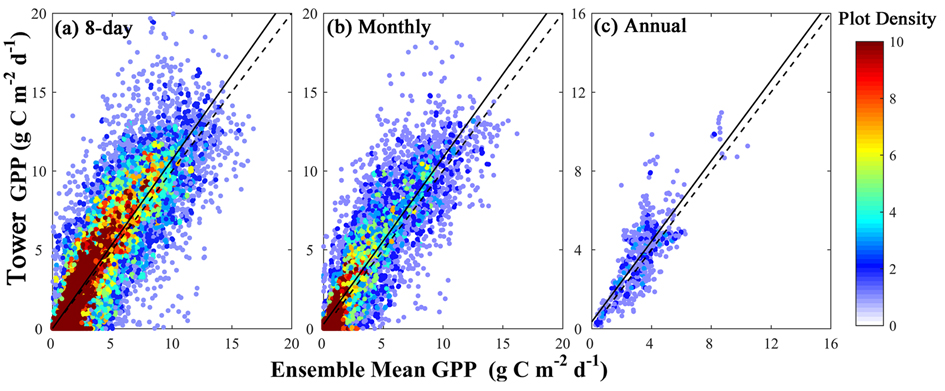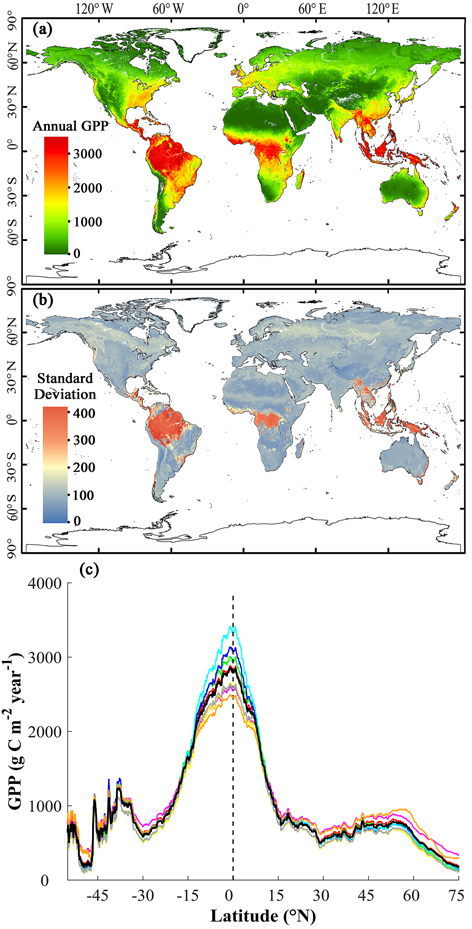|
|
|
GOSIF GPP
|
GOSIF GPP - A global, fine-resolution dataset of gross primary production (GPP) based on OCO-2 Description: (Update on May 14, 2023: We corrected a mistake in generating the data for 2022 that were released in early April 2023. If you previously downloaded the 2022 data, please replace them with the new files.) (Update on April 2, 2023: GOSIF GPP has been extended to December 2022.) (Update on April 29, 2022: GOSIF GPP has been extended to December 2021.) (Update on March 15, 2021: GOSIF GPP has been extended to December 2020.) (Release of v2 on 12/1/2019: The new version (V2) has been updated from the original version in the following ways: (1) the dataset has been extended to 2018; (2) GOSIF has been slightly improved using five subcommittee models rather than three subcommittee models; (3) a new data type (unsigned short rather than double) and a scale factor were used to reduce data volume.) Accurately quantifying gross primary production (GPP) globally is critical for assessing plant productivity, carbon balance, and carbon-climate feedbacks, while current GPP estimates exhibit substantial uncertainty. Solar-induced chlorophyll fluorescence (SIF) observed by the Orbiting Carbon Observatory-2 (OCO-2) has offered unprecedented opportunities for monitoring land photosynthesis, while its sparse coverage remains a bottleneck for mapping finer-resolution GPP globally. We used the global, OCO-2-based SIF product (GOSIF) and linear relationships between SIF and GPP to map GPP globally at a 0.05° spatial resolution and 8-day time step for the period from 2000 to 2020. To account for the uncertainty of GPP estimates resulting from the SIF-GPP relationship, we used a total of eight SIF-GPP relationships with different forms (universal and biome-specific, with and without intercept) at both site and grid cell levels to estimate GPP. Our results showed that all of the eight SIF-GPP relationships performed well in estimating GPP globally. The ensemble mean 8-day GPP was generally highly correlated with flux tower GPP for 91 eddy covariance flux sites across the globe (R2 = 0.74, Root Mean Square Error = 1.92 g C m−2 d−1). Our fine-resolution GPP estimates showed reasonable spatial and seasonal variations across the globe and fully captured both seasonal cycles and spatial patterns present in our coarse-resolution (1°) GPP estimates based on coarse-resolution SIF data directly aggregated from discrete OCO-2 soundings. SIF-GPP relationships with different forms could lead to significant differences in annual GPP particularly in the tropics. Our ensemble global annual GPP estimate (135.5 ± 8.8 Pg C yr−1) is between the median estimate of non-process based methods and the median estimate of process-based models. Our GPP estimates showed interannual variability in many regions and exhibited increasing trends in many parts of the globe particularly in the Northern Hemisphere. Our new, independent GPP product (GOSIF GPP), freely available at our data repository, will be valuable for studying photosynthesis, carbon cycle, agricultural production, and ecosystem responses to climate change and disturbances, informing ecosystem management, and benchmarking terrestrial biosphere and Earth system models. The methodology, validation, and spatial and temporal patterns of this product are described in our paper (Li and Xiao, 2019).
Citation: Li, X., Xiao, J. (2019) Mapping photosynthesis solely from solar-induced chlorophyll fluorescence: A global, fine-resolution dataset of gross primary production derived from OCO-2. Remote Sensing, 11(21), 2563; https://doi.org/10.3390/rs11212563. [PDF] Metadata: Spatial resolution: 0.05 degree Spatial extent: globe Temporal resolution: 8 day (and monthly) Temporal extent: 2000 - 2022 For each time step, GOSIF GPP consists of the mean and standard deviation (SD) of GPP; the mean and SD are based on the eight different sets of GPP estimates; mean is recommended for most analyses, and SD can be used to account for the uncertainty of GPP. Fair Data Use Policy: We make this data product available to the research community as we believe that the dissemination of this data set will lead to advancement in science. If you plan to use our data in a manuscript or presentation, we request that you inform us at an early stage of your work. If this data set is essential to your work, or if an important result or finding depends on the GOSIF GPP data, co-authorship may be appropriate. You must inform us of your analysis and publication plans well in advance of submission of a paper, give us an opportunity to read and intellectually contribute to the manuscript, and, if appropriate, offer co-authorship. Contact: Drs. Jingfeng Xiao (j.xiao@unh.edu) and Xing Li (zxwlxty@163.com). Download GOSIF GPP: Please read the fair data use policy above before you download the data. The GOSIF GPP data set (v2) is available at the Global Ecology Data Repository (Download GOSIF GPP).
|


